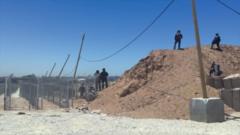Amidst significant security challenges, Pakistan's drone operations against militants raise concerns of collateral damage and political repercussions, reflecting a controversial strategy shift.
The Drones of Conflict: Pakistan's Shadow War Against Militants

The Drones of Conflict: Pakistan's Shadow War Against Militants
As internal security falters, Pakistan has turned to drones for counterinsurgency, echoing strategies once condemned in U.S. operations.
In recent months, Pakistan has found itself caught in a dual battle: one against external threats, such as its long-time adversary India, showcased by recent military skirmishes utilizing advanced drone technology, and the other occurring internally, where a secretive campaign against militants is unfolding.
As Islamist extremism resurfaces alongside rising separatist tensions, Pakistan's security forces have increasingly incorporated drone strikes as a tactical response to these internal threats, specifically in remote areas bordering Afghanistan. This strategy marks a significant pivot for a nation that, for years, vocally criticized the United States for its own drone warfare practices, which often resulted in the loss of civilian lives.
Though the Pakistani government has yet to officially acknowledge the drone campaign, reports of civilian casualties have emerged, echoing the consequences faced during U.S. drone strikes. While security officials claim that precision in targeting has improved, the risk of collateral damage continues to loom large, potentially alienating citizens and fueling resentment toward the government.
As this internal conflict continues, Pakistan stands at a crossroads, grappling with the complexities and ethical dilemmas of employing drone warfare—a method previously denounced when used by foreign powers. The implications of this strategic evolution will undoubtedly resonate throughout the region, influencing public sentiment and national security for years to come.





















